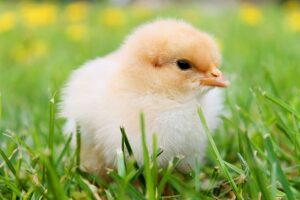So, you’ve got chicks on the way. Congratulations on this chirpy little chapter! Whether you’re starting your own backyard flock or adding to an existing one, raising chicks is one of the most rewarding (and sometimes chaotic) experiences. But don’t worry—you’ve got this. From setting up the brooder to monitoring their behavioral milestones, here’s everything you need to know about brooding chicks the first eight weeks of your baby chicks’ lives.
Brooder Setup (Pre-Arrival Preparation)
First things first—you’ll need a brooder. Think of it as the chicks’ VIP suite to hang out in while they grow. Here’s what to keep in mind when setting up their temporary home.
Location Requirements
- Find a draft-free area where your chicks won’t be chilly. Nobody likes a cold breeze sneaking in when they’re trying to nap.
- Keep their space protected from predators—this can be anything from curious cats to raccoons trying to sneak a snack.
- Ensure the temperature is consistent. Fluctuations can stress the little fluff balls, and we’re all about cozy vibes here.
- Place the brooder away from other birds, especially adult chickens, to avoid health risks.
Space Requirements
- Week 1 chicks are tiny but mighty, and they need about 0.5 square feet per chick to strut their stuff.
- Increase the space weekly as they grow (because, spoiler alert, they grow super fast). Overcrowding can lead to stress and squabbles—your brooder shouldn’t feel like rush hour on the subway.
Essential Equipment
- Heat Source – Without their mama to keep them warm, you’ll need a brooder lamp or a heat plate. (Pro tip: test your setup a day before they arrive.)
- Thermometer – Place it at chick-level to monitor their environment. High-tech? No. Useful? Very.
- Brooder Walls – High enough to prevent chicks from making unscheduled escape attempts.
- Ventilation – Fresh air, good. Drafts, bad.
Bedding Selection
- Opt for materials like pine shavings (avoid cedar—it’s harmful).
- Add about 2-3 inches of bedding to keep their little feet comfortable.
- Remember to clean it regularly. Chicks are messy. Really messy.
Temperature Management
Chicks aren’t just fluffy—they’re temperature-sensitive little divas.
Weekly Temperature Requirements
- Week 1? A toasty 95°F. Reduce by 5°F each week until Week 5, when temperatures can become more ‘room temp.’
- By Weeks 7-8, they’ll be sturdy (and feathery) enough to handle outdoor conditions.
Monitoring Methods
- Chick behavior is a thermostat in itself. Huddling? They’re cold. Scattered in the corners? Too hot. Spread evenly? Perfect!
- Create “temperature zones” by keeping the heat source on one side of the brooder, giving chicks a warm spot and a cooler retreat.
Feeding Program
You know that feeling when you’re hangry? Chicks do, too.
First 48 Hours
- Start with a high-quality starter feed. Think of it as their baby formula but for little beaks.
- Make sure it’s fine in size for their itty-bitty mouths. If it looks more like gravel than food, crush it up!
Weekly Nutritional Needs
- Protein is the name of the game. Chicks thrive on a diet with at least 20% protein in those first few weeks.
- Don’t forget the vitamins and minerals—they make chicks strong and give their feathers that extra glow-up.
Feeder Management
- Use feeder trays to prevent food spillage (and reduce your post-meal cleanup duty).
- Adjust the height as they grow to stop them from scooping out their food just for fun.
Special Supplements
- Probiotics and electrolytes can help during stressful times, like your first “heat lamp went out in the middle of the night” crisis.
- Add grit to help them digest solids when it’s time for treats (timing is important—no treats before 2 weeks old!).
Behavior & Development Milestones
Aaaah, the milestones. You’ll be shocked by how fast these fluff nuggets transform!
Week 1 Highlights
- They’ll learn to walk, eat, and drink like pros (well, mostly—they might fall over a few times).
- Look out for pasty butt (yes, it’s a thing). Wipe their backsides gently if you see poop build-up—it blocks them from doing their business.
Weeks 2-3
- Wing feathers will start to emerge—someone’s growing up.
- Expect lots of energy and an increase in social behaviors as they start developing their pecking order.
Weeks 4-6
- Their super-cute chick fluff will give way to feathers. Fair warning, they might look a little awkward during the transition phase.
- You’ll also start noticing gender differences if they’re a mixed group.
Week 7-8
- Fully feathered and growing fast, your chicks will be prepping for independence. Are you ready to move them outside?
Health & Emergency Preparedness
Daily health checks are essential. Look for bright eyes, clean nostrils, and active behavior. If you spot anything unusual—lethargy, drooping wings, or strange noises—it’s time to investigate or call a vet.
Power outages or other emergencies can put your chicks at risk. Keep a backup heat source (like hand warmers) and emergency supplies on hand.
Transition Management
By Week 8, your chicks will be ready to transition outdoors. Make sure they’re accustomed to cooler temperatures and have secure housing. Integration with an adult flock should be gradual—with supervision to prevent bullying.
Wrapping Up
Raising chicks might seem daunting at first, but trust me, it’s worth every moment of effort. From those first peeps to watching them thrive outside, each milestone is a testament to your care and attention.
Got questions or funny chick anecdotes? Drop them in the comments below—we’re all in this (feathery) adventure together! 🐥
For more on chicken care:
Chicken Foraging and Free Ranging
Best Chicken Breeds for Egg Laying
Safely Introducing New Hens to Your Flock

